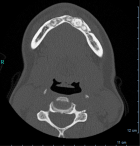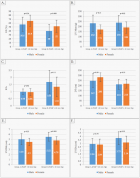Abstract
Case Report
Abnormal uterine bleeding and severe anemia cause the life-threatening condition
Bursać D, Culej Diana*, Planinić Radoš G, Župan J, Perković P, Duić Ž and Gašparov S
Published: 22 November, 2022 | Volume 5 - Issue 4 | Pages: 096-097
The World Health Organisation (WHO) defines anemia as a global public health problem. It is a medical condition in which the number of red blood cells or the hemoglobin concentration within them is below the physiological range. We present a case of a 40-year-old woman with Abnormal Uterine Bleeding (AUB) accompanied by malaise, weakness, and tachycardia. The patient reported heavy menstrual bleeding for the past 14 days. Speculum examination revealed that the bleeding was from the uterus. There were no pathological findings during a gynecological and transvaginal ultrasound examination. A complete blood count performed at the time of her arrival showed a low hemoglobin level of 24 g/L, a low hematocrit level of 7,4%, a mean corpuscular volume of 98,7 fL and a number of red blood cells 0,75 x 1012/L. Due to the severity of the anemia, she was given 6 units of red blood cell transfusion, 2 fresh frozen plasmas and tranexamic acid accompanied with calcium carbonate. The curettage was performed. The pathohistological finding was endometrium in proliferation. Afterward, the hemoglobin level increased to 90 g/L. Their past medical history revealed that she abused alcohol. On an abdominal CT scan, Alcohol-Related Liver Disease (ARLD) was confirmed. We should keep in mind that coagulopathy could be the underlying cause of abnormal uterine bleeding and that anemia must be analyzed for successful treatment. A multidisciplinary approach to anemia caused by AUB is required in cases of severe anemia.
Read Full Article HTML DOI: 10.29328/journal.cjog.1001115 Cite this Article Read Full Article PDF
Keywords:
Abnormal uterine bleeding; Anemia; Coagulopathy
References
- World Health Organization (WHO). Anemia in women and children. Accessed October 8, 2022. https://www.who.int/data/gho/data/themes/topics/anaemia_in_women_and_children.
- Cappellini MD, Musallam KM, Taher AT. Iron deficiency anaemia revisited. J Intern Med. 2020 Feb;287(2):153-170. doi: 10.1111/joim.13004. Epub 2019 Nov 12. PMID: 31665543.
- Munro MG, Critchley HO, Broder MS, Fraser IS; FIGO Working Group on Menstrual Disorders. FIGO classification system (PALM-COEIN) for causes of abnormal uterine bleeding in nongravid women of reproductive age. Int J Gynaecol Obstet. 2011 Apr;113(1):3-13. doi: 10.1016/j.ijgo.2010.11.011. Epub 2011 Feb 22. PMID: 21345435.
- Committee on Practice Bulletins—Gynecology. Practice bulletin no. 128: diagnosis of abnormal uterine bleeding in reproductive-aged women. Obstet Gynecol. 2012 Jul;120(1):197-206. doi: 10.1097/AOG.0b013e318262e320. PMID: 22914421.
- Munro MG, Mainor N, Basu R, Brisinger M, Barreda L. Oral medroxyprogesterone acetate and combination oral contraceptives for acute uterine bleeding: a randomized controlled trial. Obstet Gynecol. 2006 Oct;108(4):924-9. doi: 10.1097/01.AOG.0000238343.62063.22. PMID: 17012455.
- Gavaler JS, Van Thiel DH. The association between moderate alcoholic beverage consumption and serum estradiol and testosterone levels in normal postmenopausal women: relationship to the literature. Alcohol Clin Exp Res. 1992 Feb;16(1):87-92. doi: 10.1111/j.1530-0277.1992.tb00642.x. PMID: 1558307.
- Lukes AS, Moore KA, Muse KN, Gersten JK, Hecht BR, Edlund M, Richter HE, Eder SE, Attia GR, Patrick DL, Rubin A, Shangold GA. Tranexamic acid treatment for heavy menstrual bleeding: a randomized controlled trial. Obstet Gynecol. 2010 Oct;116(4):865-875. doi: 10.1097/AOG.0b013e3181f20177. PMID: 20859150.
- Sundstrom A, Seaman H, Kieler H, Alfredsson L.The risk of venosus thromboembolisam associated with the use of tranexemic acid and other drugs used to treat menometrorrhagia: case control study using General Practice Research Database. BJOG. 2009;116:91.
Figures:
Similar Articles
-
Experience with trans radial uterine artery embolisation for uterine fibroids in a tertiary center in Saudi ArabiaGehan Farid*,Reem Kamal,Mohammed Thani Al-Shammari,Mohamed Swaraldahab,Hassan Swaraldahab. Experience with trans radial uterine artery embolisation for uterine fibroids in a tertiary center in Saudi Arabia. . 2020 doi: 10.29328/journal.cjog.1001072; 3: 167-174
-
Chronic endometritis in in vitro fertilization failure patientsAfaf T Elnashar*,Mohamed Sabry. Chronic endometritis in in vitro fertilization failure patients. . 2020 doi: 10.29328/journal.cjog.1001073; 3: 175-181
-
Factors associated with utilization of Iron with Folic Acid (IFA) supplement among pregnant women attending antenatal care at government health facilities and family guidance clinic in Hawassa City Administration, Hawassa, EthiopiaFekadu Merse,Lolemo Kelbiso,Amanuel Fanta*. Factors associated with utilization of Iron with Folic Acid (IFA) supplement among pregnant women attending antenatal care at government health facilities and family guidance clinic in Hawassa City Administration, Hawassa, Ethiopia. . 2022 doi: 10.29328/journal.cjog.1001108; 5: 055-060
-
Intravenous leiomyomatosis of the uterus: still discovered on anatomopathological examinationAbir Karoui*,Ahmed Cherif,Olfa Chaffai,Wassim Saidi,Ghada Sahraoui,Sana Menjli,Mohamed Badis Chanoufi,Nadia Boujelbene,Hssine Saber Abouda. Intravenous leiomyomatosis of the uterus: still discovered on anatomopathological examination. . 2022 doi: 10.29328/journal.cjog.1001113; 5: 090-092
-
Abnormal uterine bleeding and severe anemia cause the life-threatening conditionBursać D,Culej Diana*,Planinić Radoš G,Župan J,Perković P,Duić Ž,Gašparov S. Abnormal uterine bleeding and severe anemia cause the life-threatening condition. . 2022 doi: 10.29328/journal.cjog.1001115; 5: 096-097
-
Racial and Ethnic Disparities in Pregnancy-related Complications: Findings at Mansa General Hospital and 2nd Affiliated Hospital of Nanjing Medical UniversityKasonde Chanda, Liang Sheng Lian, Kong Yi Yan, Huang Qian, Gulidiya Abulikem, Royd Nkalamo Nonde, Ying Xiao Yan*. Racial and Ethnic Disparities in Pregnancy-related Complications: Findings at Mansa General Hospital and 2nd Affiliated Hospital of Nanjing Medical University. . 2023 doi: 10.29328/journal.cjog.1001131; 6: 065-075
-
Impact of Primary Cesarean Section on Grand Multiparous WomenKabbashi Mohammed Adam Hammad, Awadalla Abdelwahid Suliman*, Hajar Suliman Ibrahim Ahmed, Emad Abdalla Siddig Omer, Siddig Omer M Handady. Impact of Primary Cesarean Section on Grand Multiparous Women. . 2023 doi: 10.29328/journal.cjog.1001140; 6: 126-131
-
Near-miss Women Causes and Prevalence in Alobied Maternity HospitalAyat Eltigani, Taha Umbeli Ahmed, Awadalla Abdelwahid Suliman*, Abdelsalam SalahEldin, Isra Siralkatim, Hajar Suliman. Near-miss Women Causes and Prevalence in Alobied Maternity Hospital. . 2023 doi: 10.29328/journal.cjog.1001149; 6: 185-192
-
A Retrospective Analysis of Maternal Mortality in a Tertiary Care Centre at District LevelDeepika Dhundi*, Kshama Kedar, Nova Shinde. A Retrospective Analysis of Maternal Mortality in a Tertiary Care Centre at District Level. . 2024 doi: 10.29328/journal.cjog.1001166; 7: 064-068
Recently Viewed
-
Sinonasal Myxoma Extending into the Orbit in a 4-Year Old: A Case PresentationJulian A Purrinos*, Ramzi Younis. Sinonasal Myxoma Extending into the Orbit in a 4-Year Old: A Case Presentation. Arch Case Rep. 2024: doi: 10.29328/journal.acr.1001099; 8: 075-077
-
Timing of cardiac surgery and other intervention among children with congenital heart disease: A review articleChinawa JM*,Adiele KD,Ujunwa FA,Onukwuli VO,Arodiwe I,Chinawa AT,Obidike EO,Chukwu BF. Timing of cardiac surgery and other intervention among children with congenital heart disease: A review article. J Cardiol Cardiovasc Med. 2019: doi: 10.29328/journal.jccm.1001047; 4: 094-099
-
Advancing Forensic Approaches to Human Trafficking: The Role of Dental IdentificationAiswarya GR*. Advancing Forensic Approaches to Human Trafficking: The Role of Dental Identification. J Forensic Sci Res. 2025: doi: 10.29328/journal.jfsr.1001076; 9: 025-028
-
Scientific Analysis of Eucharistic Miracles: Importance of a Standardization in EvaluationKelly Kearse*,Frank Ligaj. Scientific Analysis of Eucharistic Miracles: Importance of a Standardization in Evaluation. J Forensic Sci Res. 2024: doi: 10.29328/journal.jfsr.1001068; 8: 078-088
-
Toxicity and Phytochemical Analysis of Five Medicinal PlantsJohnson-Ajinwo Okiemute Rosa*, Nyodee, Dummene Godwin. Toxicity and Phytochemical Analysis of Five Medicinal Plants. Arch Pharm Pharma Sci. 2024: doi: 10.29328/journal.apps.1001054; 8: 029-040
Most Viewed
-
Evaluation of Biostimulants Based on Recovered Protein Hydrolysates from Animal By-products as Plant Growth EnhancersH Pérez-Aguilar*, M Lacruz-Asaro, F Arán-Ais. Evaluation of Biostimulants Based on Recovered Protein Hydrolysates from Animal By-products as Plant Growth Enhancers. J Plant Sci Phytopathol. 2023 doi: 10.29328/journal.jpsp.1001104; 7: 042-047
-
Sinonasal Myxoma Extending into the Orbit in a 4-Year Old: A Case PresentationJulian A Purrinos*, Ramzi Younis. Sinonasal Myxoma Extending into the Orbit in a 4-Year Old: A Case Presentation. Arch Case Rep. 2024 doi: 10.29328/journal.acr.1001099; 8: 075-077
-
Feasibility study of magnetic sensing for detecting single-neuron action potentialsDenis Tonini,Kai Wu,Renata Saha,Jian-Ping Wang*. Feasibility study of magnetic sensing for detecting single-neuron action potentials. Ann Biomed Sci Eng. 2022 doi: 10.29328/journal.abse.1001018; 6: 019-029
-
Pediatric Dysgerminoma: Unveiling a Rare Ovarian TumorFaten Limaiem*, Khalil Saffar, Ahmed Halouani. Pediatric Dysgerminoma: Unveiling a Rare Ovarian Tumor. Arch Case Rep. 2024 doi: 10.29328/journal.acr.1001087; 8: 010-013
-
Physical activity can change the physiological and psychological circumstances during COVID-19 pandemic: A narrative reviewKhashayar Maroufi*. Physical activity can change the physiological and psychological circumstances during COVID-19 pandemic: A narrative review. J Sports Med Ther. 2021 doi: 10.29328/journal.jsmt.1001051; 6: 001-007

HSPI: We're glad you're here. Please click "create a new Query" if you are a new visitor to our website and need further information from us.
If you are already a member of our network and need to keep track of any developments regarding a question you have already submitted, click "take me to my Query."

















































































































































